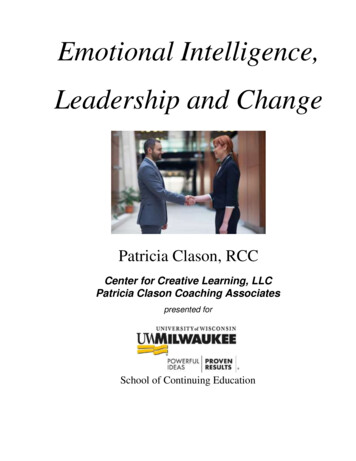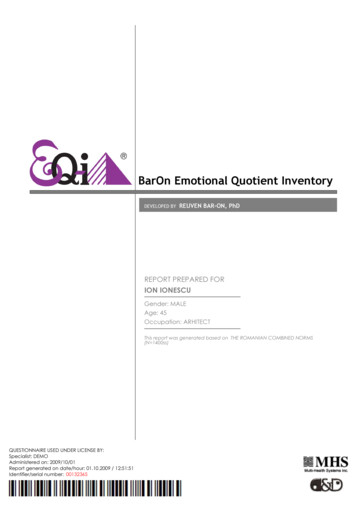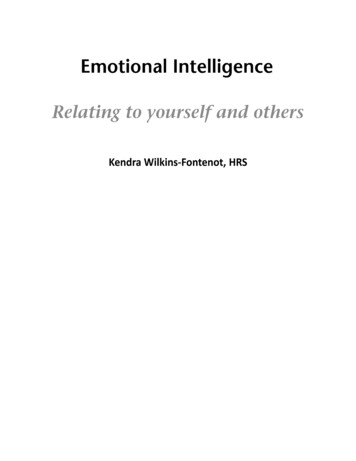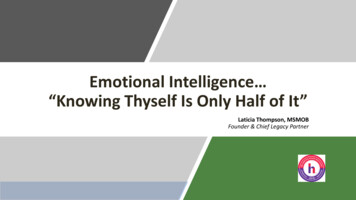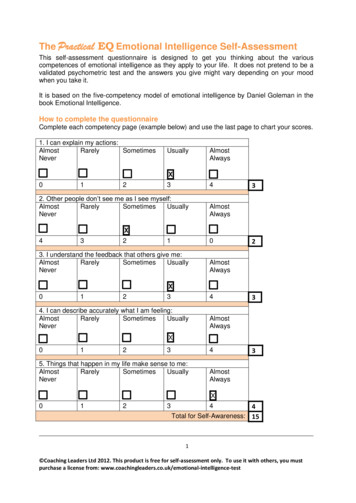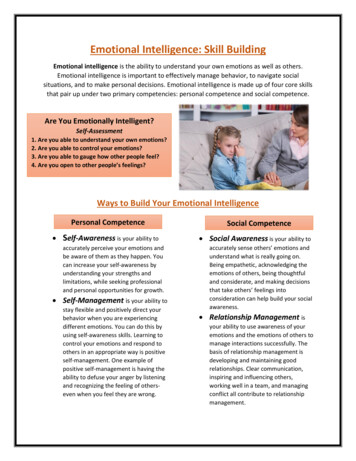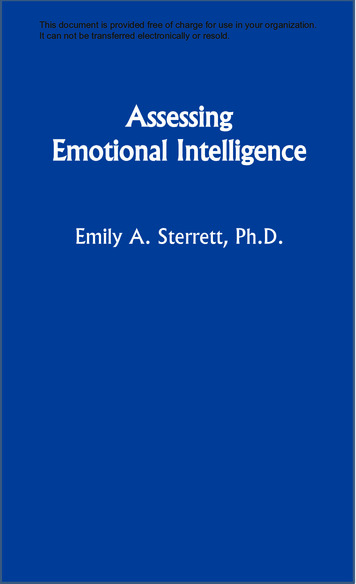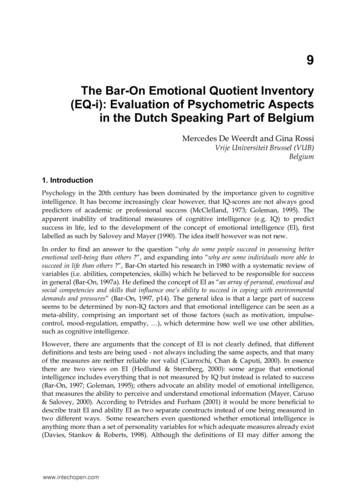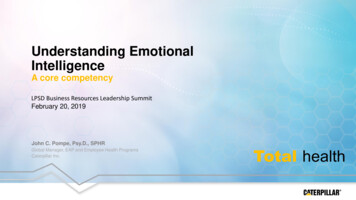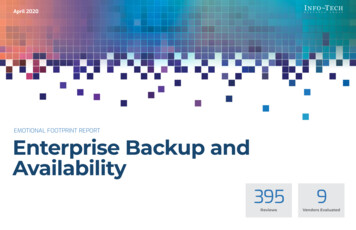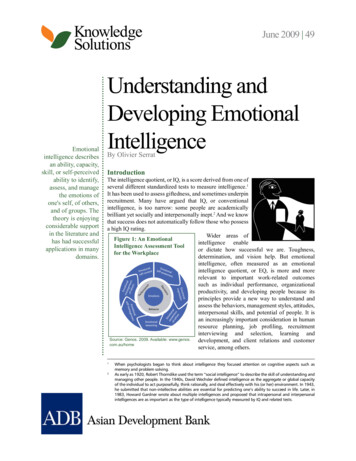
Transcription
KnowledgeSolutionsUnderstanding andDeveloping EmotionalIntelligenceBy Olivier SerratIntroductionceanmforPerltionaEmo sionsexpresioncisDeThe intelligence quotient, or IQ, is a score derived from one ofseveral different standardized tests to measure intelligence.1It has been used to assess giftedness, and sometimes underpinrecruitment. Many have argued that IQ, or conventionalintelligence, is too narrow: some people are academicallybrilliant yet socially and interpersonally inept.2 And we knowthat success does not automatically follow those who possessa high IQ rating.Wider areas ofFigure 1: An Emotionalintelligence enableIntelligence Assessment Toolor dictate how successful we are. Toughness,for the Workplacedetermination, and vision help. But emotionalintelligence, often measured as an emotionallEmotionaEmo ntrol self-aw tionalintelligence quotient, or EQ, is more and moreoa-creneselfssrelevant to important work-related outcomessuch as individual performance, organizationalproductivity, and developing people because itsEmotionsprinciples provide a new way to understand andassess the behaviors, management styles, attitudes,Behaviorinterpersonal skills, and potential of people. It isan increasingly important consideration in humanEmotionalreasoningresource planning, job profiling, recruitmentinterviewing and selection, learning andSource: Genos. 2009. Available: www.genos.development, and client relations and customercom.au/homeservice, among others.Emma otionnagalof o ementthersalttionEmo agemenanself-mEmaw otioof aren nalot eshe srsEmotionalintelligence describesan ability, capacity,skill, or self-perceivedability to identify,assess, and managethe emotions ofone's self, of others,and of groups. Thetheory is enjoyingconsiderable supportin the literature andhas had successfulapplications in manydomains.June 2009 49When psychologists began to think about intelligence they focused attention on cognitive aspects such asmemory and problem solving.As early as 1920, Robert Thorndike used the term “social intelligence” to describe the skill of understanding andmanaging other people. In the 1940s, David Wechsler defined intelligence as the aggregate or global capacityof the individual to act purposefully, think rationally, and deal effectively with his (or her) environment. In 1943,he submitted that non-intellective abilities are essential for predicting one’s ability to succeed in life. Later, in1983, Howard Gardner wrote about multiple intelligences and proposed that intrapersonal and interpersonalintelligences are as important as the type of intelligence typically measured by IQ and related tests.12
KnowledgeSolutionsDefinitionEmotional intelligence describes the ability, capacity, skill, or self-perceived ability to identify, assess, andmanage the emotions of one’s self, of others, and of groups. People who possess a high degree of emotionalintelligence know themselves very well and are also able to sense the emotions of others. They are affable,resilient, and optimistic. Surprisingly, emotional intelligence is a relatively recent behavioral model: it wasnot until the publication of Emotional Intelligence: Why It Can Matter More Than IQ by Daniel Golemanthat the term became popular.3BenefitsBy developing their emotional intelligence individualscan become more productive and successful at whatthey do, and help others become more productive andsuccessful too. The process and outcomes of emotionalintelligence development also contain many elementsknown to reduce stress—for individuals and thereforeorganizations—by moderating conflict; promotingunderstanding and relationships; and fostering stability,continuity, and harmony. Last but not least, it linksstrongly with concepts of love and spirituality.4If your emotional abilities aren’t in hand, ifyou don’t have self-awareness, if you are notable to manage your distressing emotions, ifyou can’t have empathy and have effectiverelationships, then no matter how smart youare, you are not going to get very far.—Daniel GolemanThe ModelIndividuals have different personalities, wants, needs, and ways of showing their emotions. Navigatingthrough this requires tact and shrewdness—especially if one hopes to succeed in life. This is whereemotional intelligence theory helps. In the most genericframework, five domains of emotional intelligenceEmotions have taught mankind to reason.—Marquis de Vauvenargues cover together personal (self-awareness, self-regulation,and self-motivation) and social (social awareness andsocial skills) competences.5 They are Self-Awareness(i)Emotional awareness: Recognizing one’s emotions and their effects.(ii)Accurate self-assessment: Knowing one’s strengths and limits.(iii) Self-confidence: Sureness about one’s self-worth and capabilities. Self-Regulation(i)Self-control: Managing disruptive emotions and impulses.(ii)Trustworthiness: Maintaining standards of honesty and integrity.(iii) Conscientiousness: Taking responsibility for personal performance.Emotional intelligence draws from branches of behavioral, emotional, and communications theories. Goleman is the person mostcommonly associated with it. (But he is by no means the only researcher: the most distant roots of emotional intelligence can betraced to Charles Darwin’s early work on the importance of emotional expression for survival and adaptation.) Wayne Leon Payne iscredited with first using the term “emotional intelligence” in 1985. Soon after, in 1990, John Mayer and Peter Salovey described thatas the ability to monitor one’s own and others’ feelings and emotions, to discriminate among them, and to use this information toguide one’s thinking and actions. In 1997, their four branch model defined emotional intelligence as involving the abilities to perceive,accurately, emotions in oneself and others; use emotions to facilitate thinking; understand the meaning of emotions; and manageemotions. They also tried to develop a way to scientifically measure differences between people’s abilities in the area of emotions.4Nor surprisingly, perhaps, Goleman published Social Intelligence: The New Science of Social Relationships in 2006 to illuminatetheories about attachment, bonding, and the making and remaking of memory as he examined how our brains are wired for altruism,compassion, concern, and rapport. Good relationships nourish us and support our health, while toxic relationships can poison us.He proposed that social intelligence is made up of social awareness (including empathy, attunement, empathic accuracy, and socialcognition) and social facility (including synchrony, self-presentation, influence, and concern).5The material that follows comes from the Consortium for Research on Emotional Intelligence in Organizations. 1998. EmotionalCompetence Framework. Available: www.eiconsortium.org/reports/emotional competence framework.html32
Understanding and Developing Emotional Intelligence(iv)(v)Adaptability: Flexibility in handling change.Figure 2: The Domains of EmotionalInnovativeness: Being comfortable with andIntelligenceopen to novel ideas and new information. Self-Motivation(i)Achievement drive: Striving to improve or meeta standard of excellence.Social Awa(ii)Commitment: Aligning with the goals of therenesSelf-Awarenesssgroup or organization.(iii) Initiative: Readiness to act on opportunities.Self-Motiva(iv) Optimism: Persistence in pursuing goals despitetionobstacles and setbacks.niotgulaSelf-ReSocial Skills Social Awareness(i)Empathy: Sensing others’ feelings andperspective, and taking an active interest in theirconcerns.(ii)Service orientation: Anticipating, recognizing,and meeting customers’ needs.(iii) Developing others: Sensing what others need inorder to develop, and bolstering their abilities.(iv) Leveraging diversity: Cultivating opportunitiesthrough diverse people.(v)Political awareness: Reading a group’s Source: Author.emotional currents and power relationships. Social Skills(i)Influence: Wielding effective tactics for persuasion.(ii)Communication: Sending clear and convincing messages.(iii) Leadership: Inspiring and guiding groups and people.(iv) Change catalyst: Initiating or managing change.(v)Conflict management: Negotiating and resolving disagreements.(vi) Building bonds: Nurturing instrumental relationships.(vii) Collaboration and cooperation: Working with others toward shared goals.(viii) Team capabilities: Creating group synergy in pursuing collective goals.In brief, the five domains relate to knowing your emotions; managing your emotions; motivating yourself;recognizing and understanding other people’s emotions; and managing relationships, i.e., managing theemotions of others.I respect the man who knows distinctly what he wishes. The greater part of all mischief inthe world arises from the fact that men do not sufficiently understand their own aims. Theyhave undertaken to build a tower, and spend no more labor on the foundation than would benecessary to erect a hut.—Johann Wolfgang von Goethe3
KnowledgeSolutionsTable: The Personal and Social Attributes of Emotional onal AwarenessIndividuals with this competence Know which emotions they are feeling and why; Realize the links between their feelings and what they think, do, andsay; Recognize how their feelings affect their performance; and Have a guiding awareness of their values and goals.Accurate SelfAssessmentIndividuals with this competence are Aware of their strengths and weaknesses; Reflective, learning from experience; Open to candid feedback, new perspectives, continuous learning, andself-development; and Able to show a sense of humor and perspective about themselves.Self-ConfidenceIndividuals with this competence Present themselves with self-assurance and have presence; Can voice views that are unpopular and go out on a limb for what isright; and Are decisive and able to make sound decisions despite uncertainties ls with this competence Manage their impulsive feelings and distressing emotions well; Stay composed, positive, and unflappable even in trying moments; and Think clearly and stay focused under pressure.TrustworthinessIndividuals with this competence Act ethically and are above reproach; Build trust through their reliability and authenticity; Admit their own mistakes and confront unethical actions in others; and Take tough, principled stands even if they are unpopular.ConscientiousnessIndividuals with this competence Meet commitments and keep promises; Hold themselves accountable for meeting their objectives; and Are organized and careful in their work.AdaptabilityIndividuals with this competence Smoothly handle multiple demands, shifting priorities, and rapidchange; Adapt their responses and tactics to fit fluid circumstances; and Are flexible in how they see events.InnovativenessIndividuals with this competence Seek out fresh ideas from a wide variety of sources; Entertain original solutions to problems; Generate new ideas; and Take fresh perspectives and risks in their thinking.
Understanding and Developing Emotional evement DriveCommitmentInitiativeOptimismIndividuals with this competence Are results-oriented, with a high drive to meet their objectives andstandards; Set challenging goals and take calculated risks; Pursue information to reduce uncertainty and find ways to do better; and Learn how to improve their performance.Individuals with this competence Readily make personal or group sacrifices to meet a larger organizationalgoal; Find a sense of purpose in the larger mission; Use the group's core values in making decisions and clarifying choices;and Actively seek out opportunities to fulfill the group's mission.Individuals with this competence Are ready to seize opportunities; Pursue goals beyond what is required or expected of them; Cut through red tape and bend the rules when necessary to get the jobdone; and Mobilize others through unusual, enterprising efforts.Individuals with this competence Persist in seeking goals despite obstacles and setbacks; Operate from hope of success rather than fear of failure; and See setbacks as due to manageable circumstance rather than a personalflaw.Social AwarenessEmpathyIndividuals with this competence Are attentive to emotional cues and listen well; Show sensitivity and understand others' perspectives; and Help out based on understanding other people's needs and feelings.Service OrientationIndividuals with this competence Understand customers' needs and match them to services or products; Seek ways to increase customers' satisfaction and loyalty; Gladly offer appropriate assistance; and Grasp a customer's perspective, acting as a trusted advisor.Developing OthersIndividuals with this competence Acknowledge and reward people's strengths, accomplishments, anddevelopment; Offer useful feedback and identify people's needs for development; and Mentor, give timely coaching, and offer assignments that challenge andgrow a person's skills.Leveraging DiversityIndividuals with this competence Respect and relate well to people from varied backgrounds; Understand diverse worldviews and are sensitive to group differences; See diversity as opportunity, creating an environment where diversepeople can thrive; and Challenge bias and intolerance.Political AwarenessIndividuals with this competence Accurately read key power relationships; Detect crucial social networks; Understand the forces that shape views and actions of clients, customers,or competitors; and Accurately read situations and organizational and external realities.5
KnowledgeSolutionsCompetenceAttributeSocial SkillsInfluenceCommunicationLeadershipChange CatalystConflict ManagementBuilding BondsCollaboration andCooperationTeam CapabilitiesIndividuals with this competence Are skilled at persuasion; Fine-tune presentations to appeal to the listener; Use complex strategies like indirect influence to build consensus andsupport; and Orchestrate dramatic events to effectively make a point.Individuals with this competence Are effective in give-and-take, registering emotional cues in attuningtheir message; Deal with difficult issues straightforwardly. Listen well, seek mutual understanding, and welcome sharing ofinformation fully; and Foster open communication and stay receptive to bad news as well asgood.Individuals with this competence Articulate and arouse enthusiasm for a shared vision and mission; Step forward to lead as needed, regardless of position; Guide the performance of others while holding them accountable; and Lead by example.Individuals with this competence Recognize the need for change and remove barriers; Challenge the status quo to acknowledge the need for change; Champion the change and enlist others in its pursuit; and Model the change expected of others.Individuals with this competence Handle difficult people and tense situations with diplomacy and tact; Spot potential conflict, bring disagreements into the open, and helpdeescalate; Encourage debate and open discussion; and Orchestrate win-win solutions.Individuals with this competence Cultivate and maintain extensive informal networks; Seek out relationships that are mutually beneficial; Build rapport and keep others in the loop; and Make and maintain personal friendships among work associates.Individuals with this competence Balance a focus on task with attention to relationships; Collaborate, sharing plans, information, and resources; Promote a friendly and cooperative climate; and Spot and nurture opportunities for collaboration.Individuals with this competence Model team qualities such as respect, helpfulness, and cooperation; Draw all members into active and enthusiastic participation; Build team identity, esprit de corps, and commitment; and Protect the group and its reputation and share credit.Source: Developed from Consortium for Research on Emotional Intelligence in Organizations. 1998. Emotional Competence Framework.Available: www.eiconsortium.org/reports/emotional competence framework.html6
Understanding and Developing Emotional IntelligenceCan Emotional Intelligence be Learned?A common question relates to whether people are born with high EQ or whether it can be learned. The truth isthat some will be more naturally gifted than others but the good news are that emotional intelligence skills canbe learned. (This must be so because emotional intelligenceis shown to increase with age.) However, for this to happen, Nothing great was ever achieved withoutpeople must be personally motivated, practice extensively enthusiasm.—Ralph Waldo Emersonwhat they learn, receive feedback, and reinforce their newskills.Promoting Emotional Intelligence in the WorkplaceThe work conducted in most organizations has changed dramatically in the last 20 years. Of course, thereare now fewer levels of management and management styles are less autocratic. But there has also been adecided move toward knowledge and team-based, client-oriented jobs so that individuals generally have moreautonomy, even at the lower levels of organizations. Sincemodern organizations always look to improve performance,Comfort in expressing your emotions willthey recognize that objective, measurable benefits can beallow you to share the best of yourself withderived from higher emotional intelligence. To name aothers, but not being able to control yourfew, these include increased sales, better recruitment andemotions will reveal your worst.—Bryant H. McGill retention, and more effective leadership.Naturally, the criteria for success at work are changingtoo. Staff are now judged by new yardsticks: not just by how smart they are, or by their training and expertise,but also by how well they handle themselves and one another. And that is strongly influenced by personalqualities such as perseverance, self-control, and skill in getting along with others. Increasingly, these newyardsticks are being applied to choose who will be hired and who will not, who will be let go and who will beretained, and who will be past over or promoted.Emotional intelligence may be the (long-sought) missing link that unites conventional “can do” abilitydeterminants of job performance with “will do” dispositional determinants. Modern organizations now offerlearning and development that is explicitly labeled as “emotional intelligence” or “emotional competence”training. In support, their leaders create and manage a working environment of flexibility, responsibility,standards, rewards, clarity, and commitment.6This climate determines how free staff feel to innovate unencumbered by red tape; perceptions of responsibility to the organization; thelevel of standards that are set; the sense of accuracy about performance feedback and the aptness of rewards; the clarity staff have aboutthe organization’s mission, vision, and values; and the level of commitment to a common purpose.67
KnowledgeSolutionsFigure 2: Good Practices that Cultivate Emotional Intelligence in the Workplace Paving the WayAssess the organization’s needsAssess the individualDeliver assessments with careMaximize learner choiceEncourage people to participateLink learning goals topersonal valuesAdjust expectationsGauge readiness Evaluate the ChangeEvaluate Doing the Work of ChangeFoster a positive relationship betweenthe trainers and learnersMake change self-directedSet clear goalsBreak goals into manageable stepsProvide opportunities to practiceMonitor performance and give feedbackRely on experiential methodsBuild in supportUse modelsEnhance insightEncourage Transfer and Maintenance ofChange Encourage use of skills on the job Develop an organizational culture thatsupports learningSource: Author.Note: The four phases correspond to those of the development process, viz., preparation, training, transfer and maintenance,and evaluation. Each is important.Source: Summarized and developed from Consortium for Research on Emotional Intelligence in Organizations. 1998. Guidelinesfor Best Practice. Available: r ReadingADB. 2008. Culture Theory. Manila. dge-solutions/culture-theory.pdf―――. 2009a. Working in Teams. Manila. Available: ns/working-in-teams.pdf―――. 2009b. Managing by Walking Around. Manila. Available: ons/managing-by-walking-around.pdfCharles Ehin. 2000. Unleashing Intellectual Capital. Butterworth-Heinemann.Daniel Goleman. 1995. Emotional Intelligence: Why It Can Matter More Than IQ. Bantam Books.―――. 1998. Working with Emotional Intelligence. Bantam Books.―――. 2006. Social Intelligence: The New Science of Social Relationships. Bantam Books.For further informationContact Olivier Serrat, Head of the Knowledge Management Center, Regional and Sustainable Development Department,Asian Development Bank (oserrat@adb.org).8
Understanding and Developing Emotional IntelligenceAsian Development BankADB’s vision is an Asia and Pacific region free of poverty. Its mission isto help its developing member countries reduce poverty and improvethe quality of life of their people. Despite the region’s many successes, itremains home to two thirds of the world’s poor: 1.8 billion people wholive on less than 2 a day, with 903 million struggling on less than 1.25a day. ADB is committed to reducing poverty through inclusive economicgrowth, environmentally sustainable growth, and regional integration.Based in Manila, ADB is owned by 67 members, including 48 from theregion. Its main instruments for helping its developing member countriesare policy dialogue, loans, equity investments, guarantees, grants, andtechnical assistance.Knowledge Solutions are handy, quick reference guides to tools,methods, and approaches that propel development forward and enhanceits effects. They are offered as resources to ADB staff. They may alsoappeal to the development community and people having interest inknowledge and learning.The views expressed in this publication are those of the author(s) and donot necessarily reflect the views and policies of the Asian DevelopmentBank (ADB) or its Board of Governors or the governments they represent.ADB encourages printing or copying information exclusively for personaland noncommercial use with proper acknowledgment of ADB. Users arerestricted from reselling, redistributing, or creating derivative works forcommercial purposes without the express, written consent of ADB.Asian Development Bank6 ADB Avenue, Mandaluyong City1550 Metro Manila, PhilippinesTel 63 2 632 4444Fax 63 2 636 s9
Understanding and Developing Emotional Intelligence By Olivier Serrat Introduction The intelligence quotient, or IQ, is a score derived from one of several different standardized tests to measure intelligence.1 It has been used to assess giftedness, and sometimes underp
